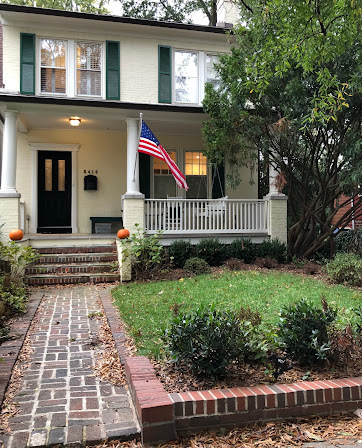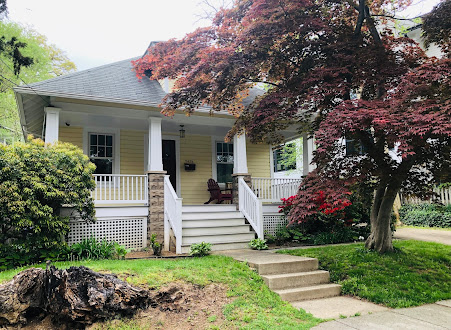By serendipity, my dive into the history of the houses on my block coincided with a volunteer job organizing the archives of the Palisades Community Church. Here I unexpectedly found a treasure trove of photos and stories of many of our neighborhood's original inhabitants, and I soon realized this was not an ordinary church.
 |
| Jo-Ann Monez with big bow once lived at 5400 Cathedral |
Legend has it that the idea of the church first started during a tennis game on a balmy evening in the summer of 1922. This was when our section of the neighborhood was called Potomac Heights. Cathedral Avenue, which predated the National Cathedral, still went by the name Jewett Street and was an unpaved little road which ran down hill towards the river.
That summer, Olive and Robert Mancill were playing doubles with Mr and Mrs. Clyde Moore when the topic came up of how to get the neighborhood children to attend Sunday school. The Mancills were Baptists, and the Moores leaned Methodist. Both had made offers to haul their neighbors' offspring to their respective churches in Georgetown, but though the parents seemed willing, the reply always seemed to be "maybe next Sunday."
Perhaps they could manage a Bible school of their own?
Both couples reached out to neighbors and asked if they wanted their children to attend a local Sunday school. The answer was a resounding "yes." They also discovered that many young families were feeling isolated and disconnected in this fledgling community of newly built homes.
 |
| newspaper ad from 1913 |
On December 5, 1922, twenty eight interested people gathered at the large Mancill home at 5410 Macomb Street. A history of the community church movement was read out loud, and people learned that many rural communities had put denominations aside in order to pool their resources. In the early 1920s, our neighborhood still had working farms. The only churches here were Our Lady of Victory and a small outpost of St Albans. Word spread, and the group met every weekend in January. They decided to call their enterprise the “Potomac Heights Bible School.”
Meanwhile, a pair of brothers, Earl and Carey Rector were erecting store fronts on MacArthur Boulevard. Earl planned to open a general at 5441 MacArthur Boulevard, but he agreed to temporarily rent the empty space for $50 a month to the Bible school. Determined to make the space work, the group found benches, borrowed hymn books, and bought a small stove. Forty-three people met on a Sunday morning, January 7th, 1923.
By March 5th the congregation had enthusiastically raised enough money for a down payment of $100 on a $1200 vacant lot just behind the store, where the driveway of the current church is now.
It was going to be a busy year.
On March 21, another neighbor, Mae Topping, hosted a luncheon at her home at 5018 MacArthur. Here, energetic ladies of the church met to brainstorm about fundraising. They decided to call themselves the "New Idea Society."
By the third meeting, the club had collected $17, and everyone voted to spend it all on a set of dishes and a tub for washing up . They held luncheons as fundraisers, and catered events at other churches. Three months later the New Idea Society had bought 516 pieces of china. Bake sales, church suppers, hat parties, and many other events would rake in enough money over the years to pay the note on the property and raise new buildings. In November 1923, the first New Idea Society bazaar raised $500, the equivalent of about $8,000 today. These women nailed fundraising.
The Bible School had to vacate the Rector’s store in May of 1923. Sunday school classes were then held all over the Mancill home including on the porches and in the kitchen. Their congregation was already taking off.
In July that same summer, the school met on Edward and Margaret Doig’s lawn The Doigs lived at 5315 Cathedral on the corner of Sherier Place. Here they heard a lecture about community churches, and the possibility of their Bible school becoming a church slipped into place.
 |
| The Doigs in 1930 |
Work progressed on a frame structure on Cathedral Avenue throughout the summer.
When the project ran out of money, neighbors picked up hammers and pitched in on weekends. The congregation was able to move into their new home in September of 1923.
On March 19, 1924, the Potomac Heights Community Church formally adopted its name and constitution with eleven Christian denominations under one roof. The inclusiveness of their doctrine was key in bringing this community together. The first community church in Washington DC had become official. Two years later, the congregation had swelled.
 |
| Partial Shot of Congregation, Cathedral Ave 1925 |
 |
| Congregation in front of bungalow 1939 |
By 1929, another small building was added, and the roof was raised to add five additional classrooms due to the overwhelming number of children in the congregation. The construction was done by church members.
The tot count reached 220 in 1931 and made up 18 Sunday school classes. That same year, the congregation agreed that space was a passing issue. The church needed a bigger boat.
The ground was broken for the current sanctuary on Sunday June 12, 1938, and the building was ready for business on January 22, 1939. The congregation numbered about 260 at this time with an additional 275 children attending services.
In 1950 the DC government changed the name of our neighborhood to Palisades. The church followed suit on January 13, 1953 and kept growing. An educational building was planned, but the next event was completely unforeseen. At 3:46 am Sunday March 3, 1957, police on a routine patrol discovered a fire which had started in the church office and spread quickly. The original wood frame building was badly damaged, but parishioners showed up at 8 am that same morning and gamely cleaned up the sanctuary in time to hold services. Their plans for a new building became even more of a priority.
On Sunday November 2, 1958 the groundbreaking for the education building took place on the site of what was the rectory bungalow. Mary Cochran, the oldest active member of the church, got first crack at the ceremonial shovel.
 |
| Mary Cochran far left |
From the very beginning the church tirelessly sought out new ways to connect this community. During the very first meeting at the Mancill home in 1923, Mr Moore said “I think social gatherings once in a while would be advisable in order to keep up the interests of the people.” Mary Cochran proposed "scoping out home talent" to put on plays . A music recital was held a month after they moved into the building in 1923. This photo - probably taken in the late 1940s, featured at least three people from the 5400 block of Cathedral Avenue including Mary Cochran (5426), David Correll (5414) and Ezra Fox (5429.)
 |
| Mary Cochran back row far left next to Dick Corell. Ezra Fox back row far right |
In 1925 church members Nettie and William McGinniss started “The Beacon,” a church and community bulletin which was named for the flashing light in the church tower.
 |
| 1939 Beacon |
Topics were covered from gardening to procuring a gas station for the neighborhood. Each issue paid for itself with ads on the back.
On Sundays the pastor would often load his cars with boys and drive around the neighborhood handing out that week’s issue to keep our community connected.
Lots of clubs met in the building. In 1933 seven Boy Scouts kicked off a troop that still exists today.
 |
| Cub Pack in 1935 |
Just a few weeks after the Social Hall was completed in 1938, Mary Cochran’s dream came true when a play called “Everybody’s Crazy” was performed on a real stage.
Since then the building has housed too many social activities to mention including a bowling league, art classes, a rabbit breeders society, and a Welsh club. Many neighbors remember the bountiful ham and oyster dinners once put on by members of the legendary New Idea Society who loved a good hat party.
 |
| 1961 |






























